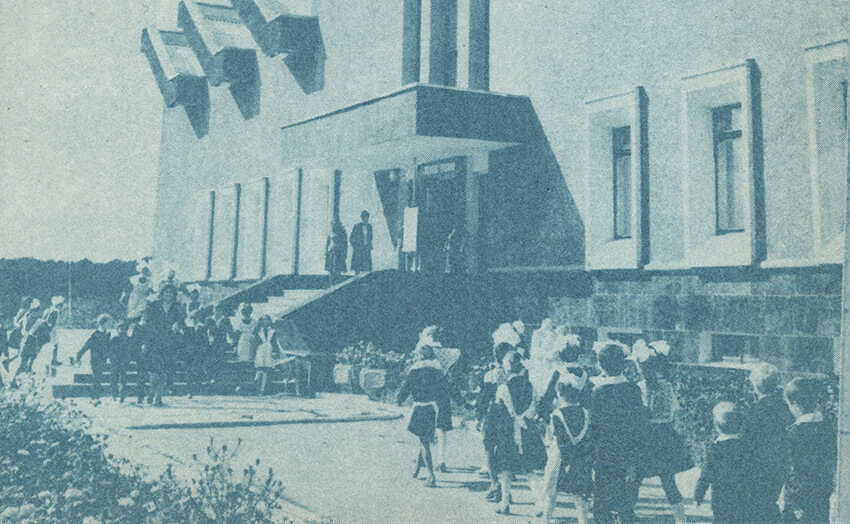
*Or is it the Kmytiv Museum of Fine Arts after Buhanchuk?
THE KMYTIV MUSEUM OF SOVIET ART*
Kmytiv is not exactly a one-road town, more like a three-road town. Nevertheless, its small stature belies its significance. In 2019, the маленьке село (small village) twenty-five minutes outside the northwestern Ukrainian city of Zhytomyr has become the country’s de facto capital of culture. The transformation has come courtesy of a collective of artists and activists led by Yevheniia Moliar, Leo Trotsenko, and Nikita Kadan. History talks in this transformation. Not everyone has been ready, or willing, to hear what it has to say.
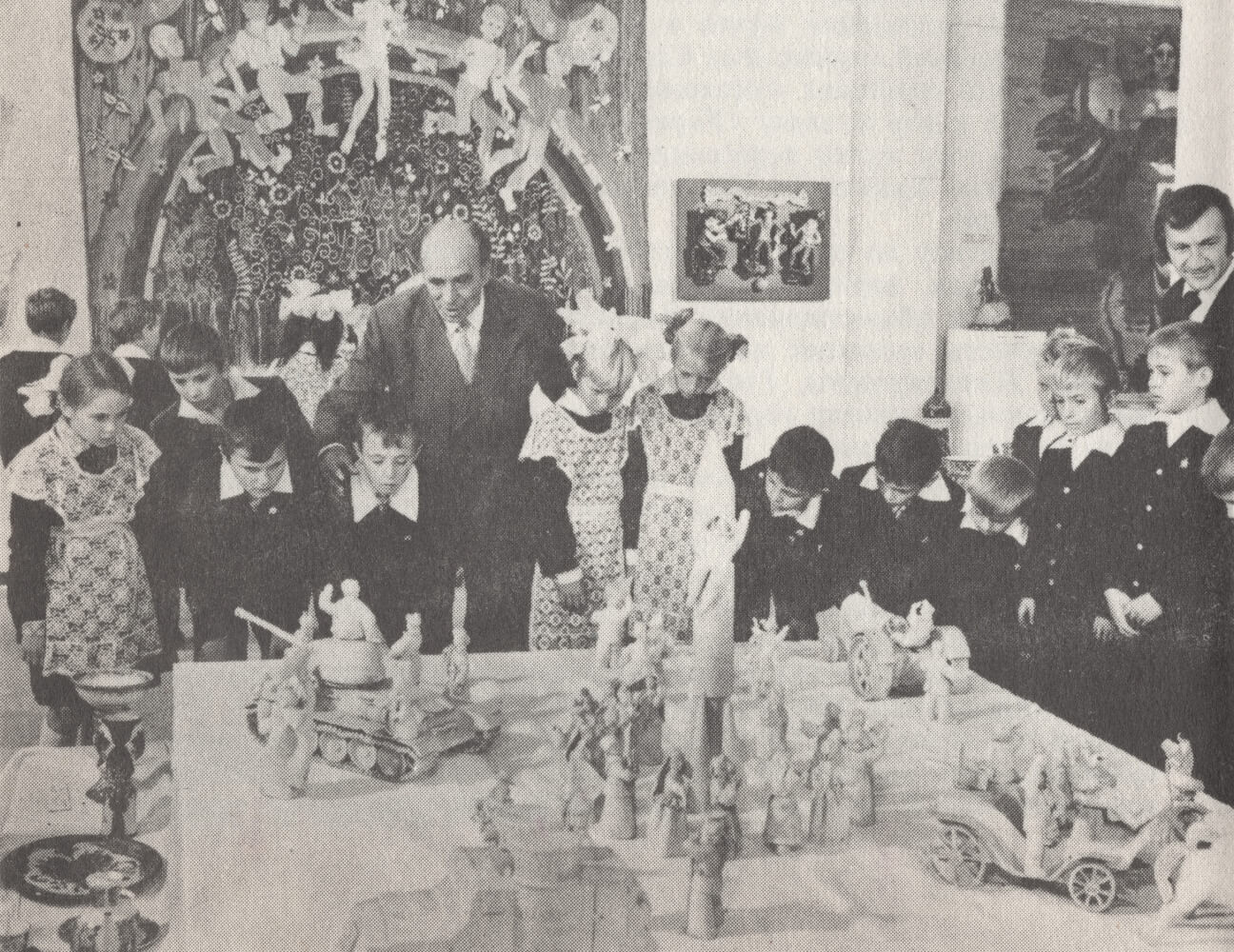
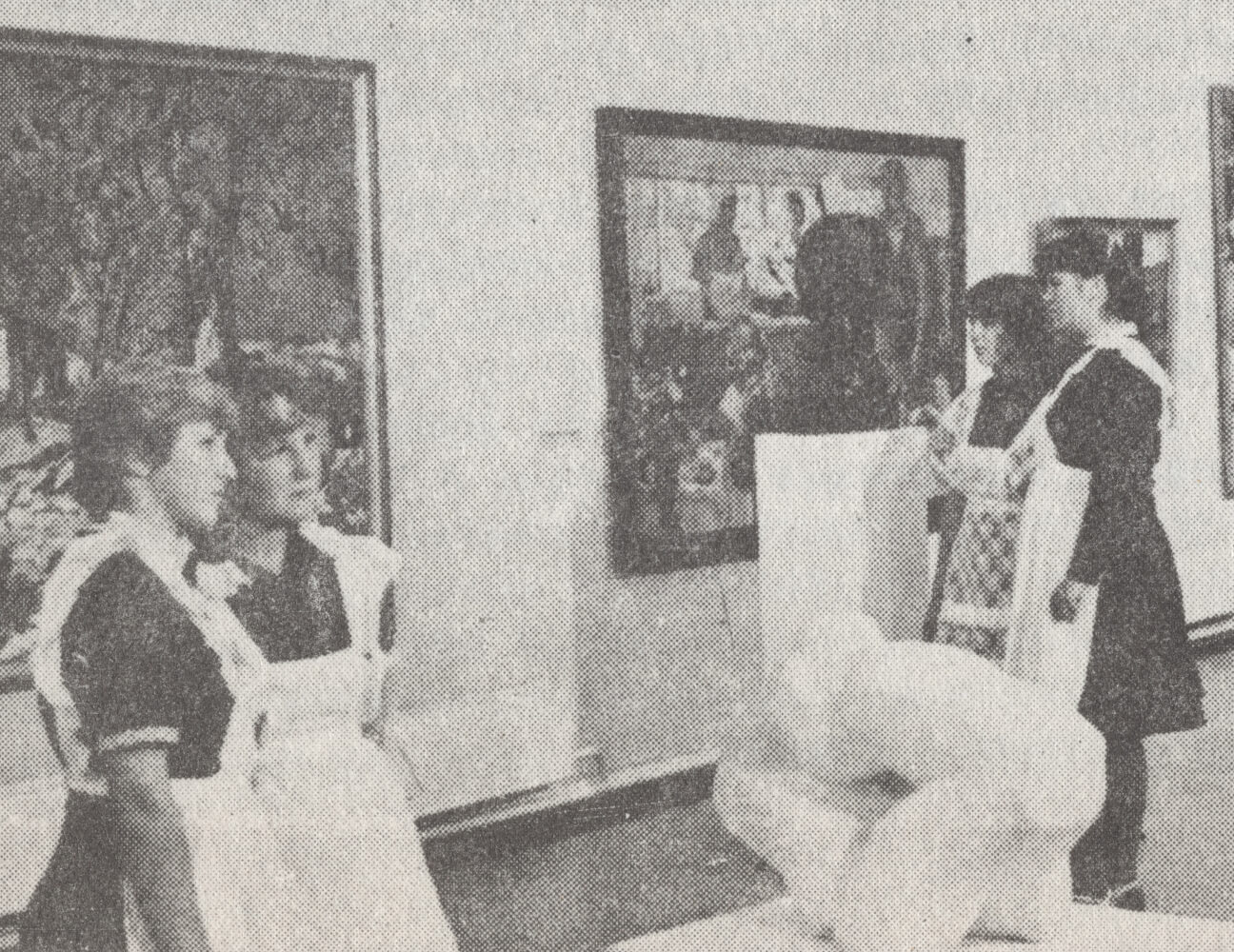
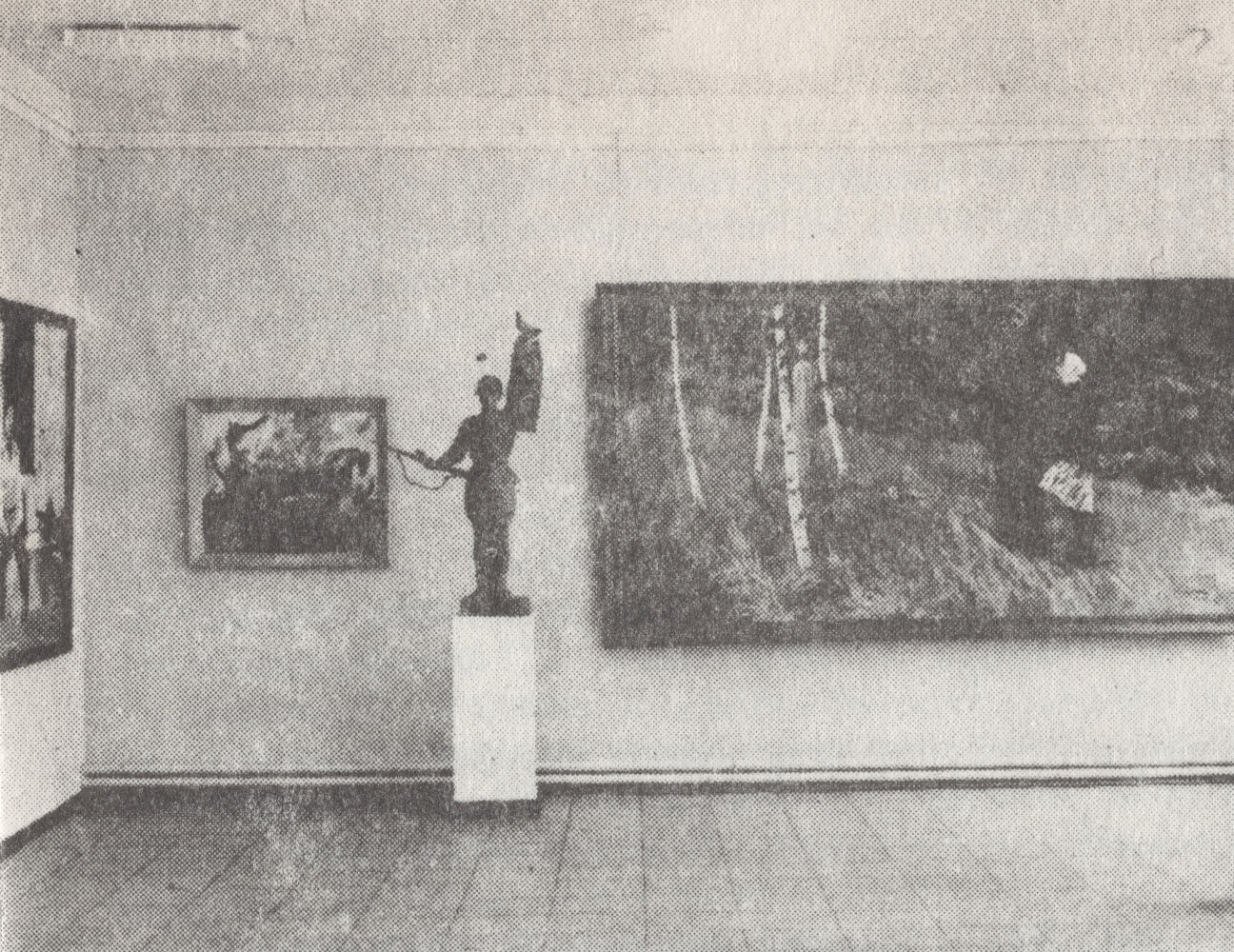
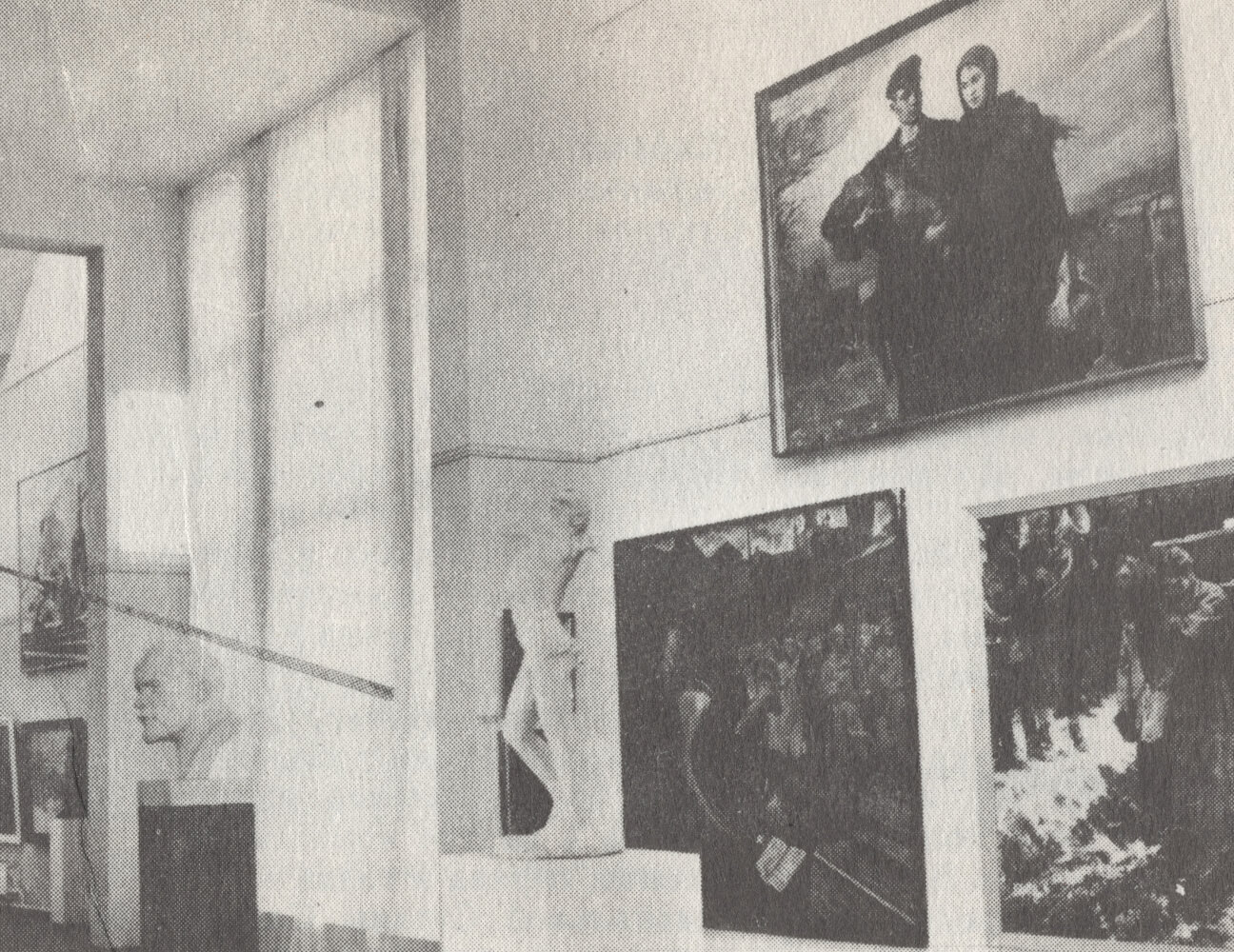
The seeds of Kmytiv’s current prominence were planted in 1985 when the Kmytiv Museum of Soviet Art opened on Lenina Street. The ultramodern building with trademark wave roof was constructed to house a 3,000+ item collection of late 20th-century art objects from the USSR’s many republics. An encyclopedic portrait of a highly particularised moment in time, the collection was the brainchild of Kmytiv native Josyp Buhanchuk—a military official turned art lover.
From the museum’s opening in 1985 to the declaration of Ukrainian independence in 1991, the museum montage synchronized with the principles of Soviet Internationalism—celebrations of victory, praises for bountiful harvests, tributes to martyrdom, and showcases of regional crafts. Such an installation was, of course, propagandizing; Socialist Realism is as Socialist Realism does. And yet, observing the archival images, the original exhibition looks more static and reflective than stirring and projective. Tanks look like toys, especially when paired with stagecoaches. A group of stern-faced teenage schoolgirls look less than inspired by what they see; the sculptures and paintings have turned them to stone. Bright white light pours in from the windows, but Lenin faces away. The light consumes him.
The era which Soviet dissident writer Joseph Brodsky called the “end of the Belle Époque” was the Kmytiv museum’s beginning. The Soviet Empire wrote the language, set the stage, introduced the cast, and authored the institution’s first chapter. Then it died, swiftly and without training a successor. Nearly three decades of ambiguity ensued. The Kmytiv Museum of Soviet Art was renamed the Kmytiv Museum of Fine Arts after Buhanchuk, despite being a museum whose collection is explicitly (and overwhelmingly satisfied to be) Soviet. Works which praised the Communist party or imperiously pictured its priorities were removed from view and ‘neutral,’ comparatively tame works—landscapes, still lifes, etc.—took their place.
The Kmytiv museum was meant to stand out. In the ’90s, ’00s, and throughout most of the ’10s, the museum became increasingly standard. With the protagonists in storage, its peak potential went unrealised. For most of this period, the revision was an administrative choice meant to appease the court of public opinion and facilitate the formation of a new national identity. That process was propelled by a package of four laws passed by Ukraine’s Верховна Рада (Parliament) in 2015. Colloquially referred to as the “Decommunization Laws,” the ratification of these wide-sweeping edicts had the inverse effect of serving as a call-to-action for preservationists, kickstarting the Kmytiv Museum of Soviet Art’s reincarnation.
Size and vulnerability define the Kmytiv collection. The confluence of those characteristics partnered with the complexities of the collection’s rural home drew the attention of veteran cultural activists Yevheniia Moliar and Leo Trotsenko in September 2018. Working in collaboration with museum director Yaroslav Khytryi and with the backing of the Ukrainian Cultural Foundation, the duo brought on Nikita Kadan as the museum’s first Curator of Contemporary Art and developed a series of programming meant to reconsider what the collection shows and what it can do.
Kadan, himself one of Ukraine’s leading contemporary artists, is unequivocal about his curatorial mandate: to rebuke “state-run mass vandalism” of Soviet visuals and prompt viewers to confront the intersection of art and ideology. Since July, he has approached this intersection from five directions in five exhibitions, termed episodes—‘Paternalism and Enlightenment,’ ‘Reading the Debris,’ ‘War in a Museum,’ ‘Today We Will Invent the Nations,’ and ‘Disobedient Bodies.’
The premise of each episode is straightforward: engage the collection in dialogue with contemporary art. And in doing so, emphasis is placed on both camp’s assets. The collection is on home turf, wise in its old(er) age, and imbued with a survivor’s instinct. The contemporary art is young, technologically savvy, and unfiltered in its critique of officialdom. Each enhances the other, by confirming, challenging, or overturning the other. The conversation proved particularly thick in the fourth episode—‘Today We Will Invent the Nations.’ Dedicated to “the construction and destruction of the national component of human coexistence,” the exhibition, which ran from October 5-25, brought together dozens of collection artists and fourteen contemporary artists, headlined by Azerbaijani artist Babi Badalov and Slovenian conceptual musicians LAIBACH.
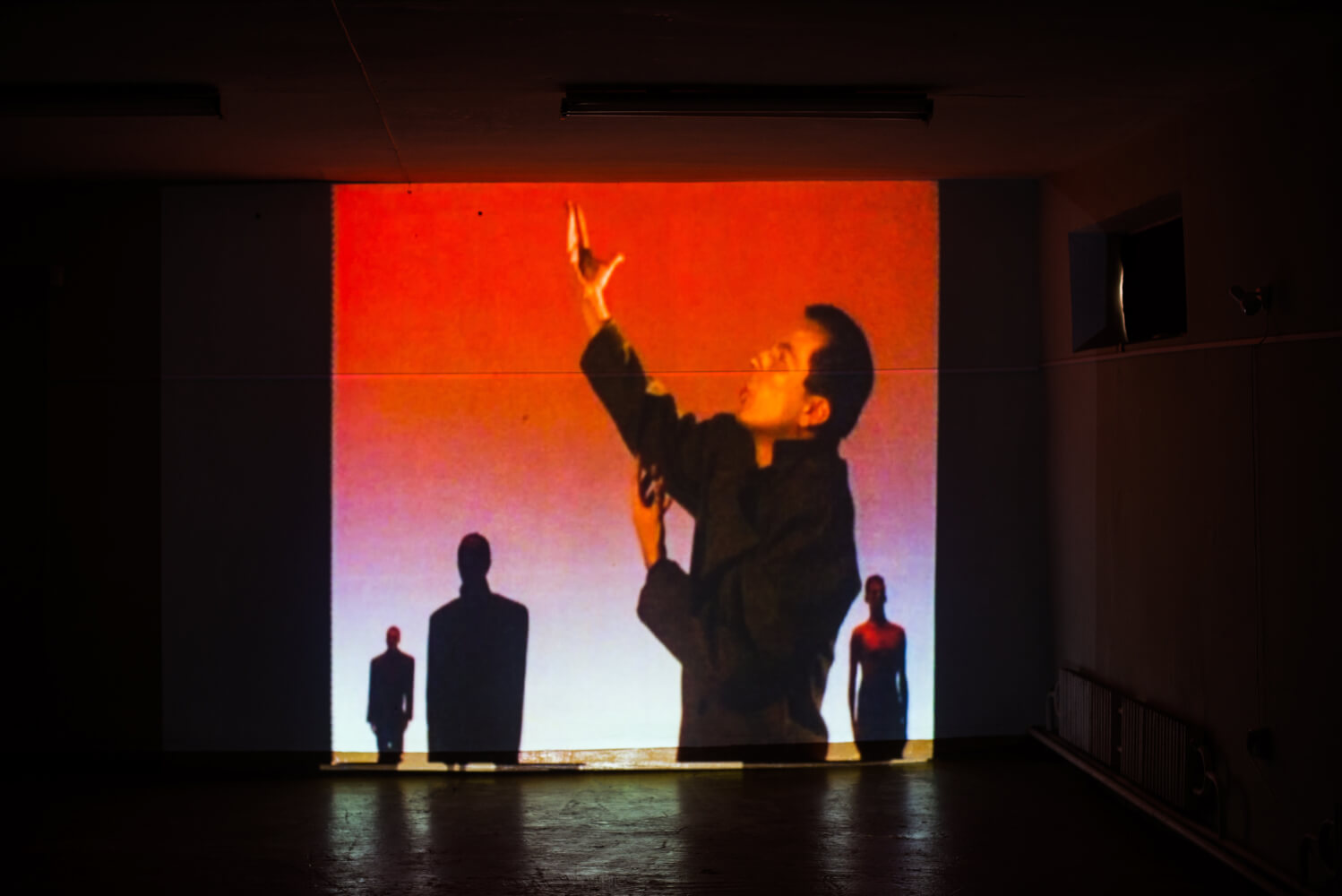
LAIBACH, “Geburt einer Nation (Opus Dei)” (1987)
According to Kadan, “the invention of nations is a process, which, on the one hand, holds on to violence and exclusion, and on the other, to poetic imagination.” The latter is Badalov’s domain—how language loops, links, lifts, locks in or liberates. Two of Badalov’s three contributions to the exhibition, “Eastkycctbo” and “ПолосаPolosa,” both textile works made onsite, appeared in an anteroom covered in intricate wood inlays. In all the shades of varnish under the sun, flora and fauna fill floor to ceiling. Badalov lets language loose. In such a fertile setting, “Eastkycctbo” and “ПолосаPolosa” were triumphantly free.
Badalov topples totalitarianism through text; LAIBACH coopts totalitarian tactics to lay bare the mechanisms of mass persuasion. The band was represented in Kmytiv by the trumpet and leather-filled video for 1987’s “Geburt einer Nation (Opus Dei).” Projected on the back wall of a dark, echoing room in the basement, the video for the pseudo-anthem was the proverbial monster under the bed—ominous in tone, obscure in form. Before you could see “Geburt einer Nation (Opus Dei), you felt it. And when you saw “Geburt einer Nation (Opus Dei),” you shuddered; you’d seen it before, but you repressed the memory.
Interpretations of the making, moulding, and manipulation of memory filled ‘Today We Will Invent the Nations.’ A particularly potent interpretation came courtesy of collection artist Yury Filipovich Ryazanov. His “May 9, 1945” (1974) awaited visitors at the top of the second-floor landing. The triptych of canvases showing Moscow celebrations of Nazi surrender is a fiery tour de force. On the left, a young boy stands eye-to-eye with the orange fireworks filling the sky. On the right, an officer and his partner hold hands and do the same. In the middle, merrymakers on the street fill the frame. The fireworks carry one of them up into the air above the Kremlin clock tower. Yet “May 9, 1945” revolves around the face in the centre of the central canvas. The man with the crew cut is so elated that he starts to appear tortured. His emotions are burning him alive.
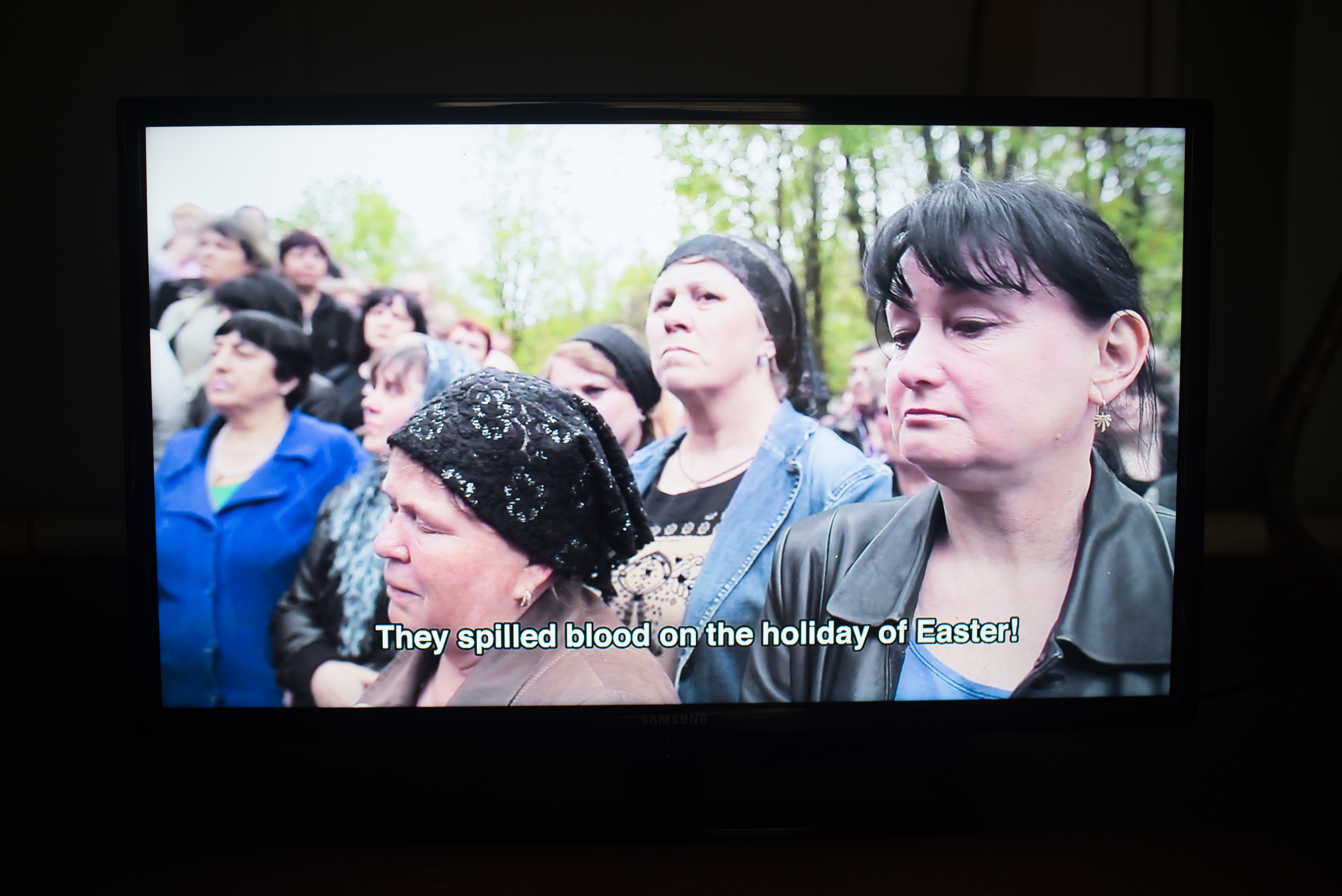
Oleksiy Radynski,
“People Who Came to Power” (2015)
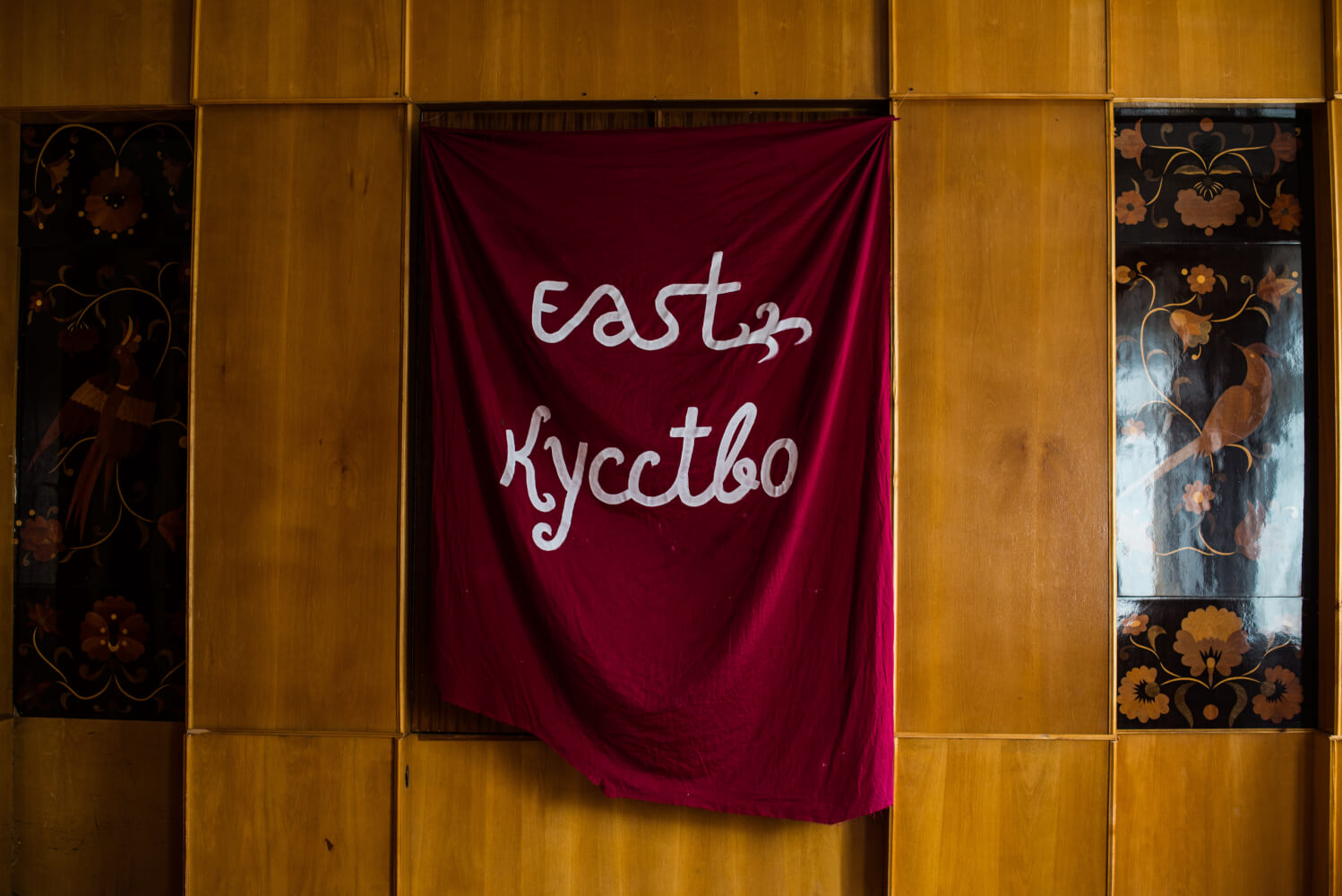
Babi Badalov, “Eastkycctbo” (2019)
Emotions run equally high in contemporary Ukrainian filmmaker Oleksiy Radynski’s “People Who Came to Power” (2015), which was shown on a screen on the floor in a closet. The film tracks the egos, obstinancies, and upheavals which led to an armed uprising and the proclamation of a republic in Ukraine’s Donbas in 2014. Radynski morphs words into metaphorical weapons. Rhetoric can have fatal consequences. Not only then, but now. And here.
“Today We Will Invent the Nations” was full of civic pride. It was also full of warnings about what happens when a flame is put to that pride. Each episode Kadan has curated has similarly worked on several levels. As Kadan puts it, each episode has its own “articulation.” The Kmytiv phenomenon is rooted in these articulations, but, ultimately, the Kmytiv phenomenon is about all that springs forth from these articulations.
The Kmytiv phenomenon is about the community that convenes once a month on a Saturday afternoon for the next episode’s opening. They come by car share and маршрутка (taxi bus), making the twenty-five-minute trip from Zhytomyr, the hour-and-a-half from Kyiv, or even further afield. There’s the woman with the pink mohawk and matching eye-shadow sipping champagne from the bottle on the front steps. There’s the fellow with black dreadlocks holding an animatronic bat. There’s the Swiss film director prone to hashtagging #thefutureiseast. There’s the security guard with the billy club in his belt whose desk is covered in pages from a kitten calendar. And, there are the collector-looking types, encircled and outnumbered by a crew of toddlers teetering around in onesies.
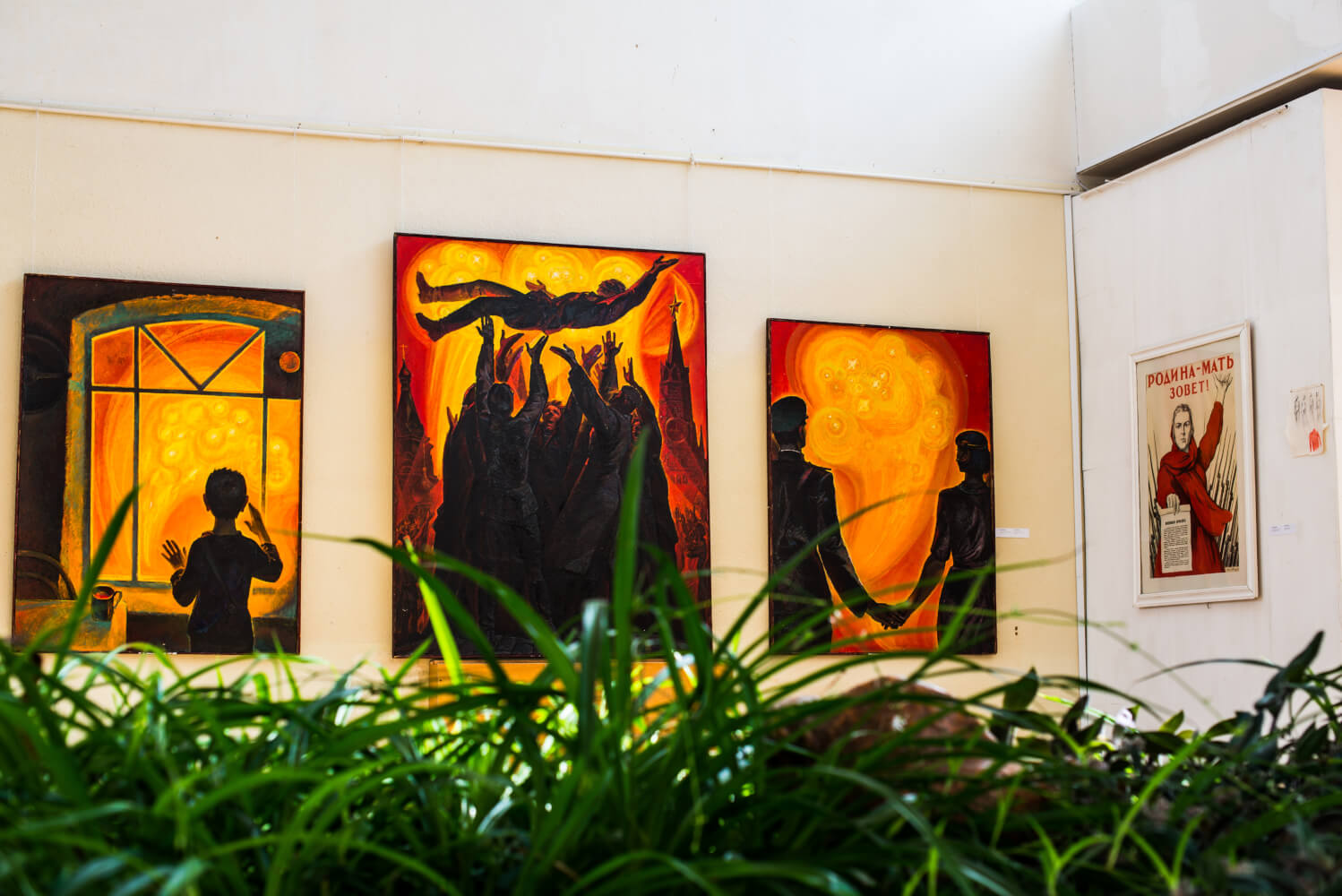
General view of ‘War in a Museum,’ including Yury Filipovich Ryazanov’s triptych “May 9, 1945” (1974)

General view of Kmytiv museum, designed by Mikhail Severov under the supervision of Igor Fomin
The Kmytiv phenomenon is about what this community does once they are assembled—listen. They listen to Kadan talk about the exhibition in extraordinary detail. They walk with him from work to work, absorbing a soliloquy which regularly extends over two hours. And afterwards many follow the lead of the mohawk; namely, they drink—usually the homemade cherry liqueur served in the museum cafe or bottles of the Belarusian beer sold at the truck-stop seven hundred meters down the road. They spill out onto the lawn to dance to industrial music, picnic, or play badminton. They stay a while, crowding the museum and animating the whole village.
The Kmytiv phenomenon is about those who object to the phenomenon. Right when the programming was gaining momentum, deputies on the Zhytomyr Regional Council representing far-right populist parties intervened. They directed their attention towards the institution’s Facebook page, which had been symbolically renamed from ‘Kmytiv Museum of Fine Arts after Buhanchuk’ to ‘Kmytiv Museum of Soviet Art.’ When their demand for the page to be blocked or taken down was not met, the tone of their threats became far more serious. Boycotts have been called for and one official went so far as to say that the prosecutor’s office “will put everyone behind bars.” The name has since been changed, but the blowback continues.
The Kmytiv phenomenon is how these outside objections are dealt with—the letters of support written by sympathizers, the kinship that forms between coordinators and community, and the funds raised to restore damaged works from the collection.
The Kmytiv phenomenon is a lot at once. Many voices grab the mic—new ones, long-silent and thought-dead ones, popular ones, marginalised ones, utopian ones, dissenting ones, and affirming ones.
The Kmytiv phenomenon is about Kmytivs.
Text: Alex Fisher
Photos: Natalka Diachenko, courtesy Kmytiv museum
Archive Photos: Unknown photographer, courtesy Kmytiv museum

